Critical Reflection on Leadership Styles: Approaches and Analysis
VerifiedAdded on 2020/01/06
|8
|2334
|237
Report
AI Summary
This report presents a critical reflection on leadership approaches, focusing on transformational and authentic leadership styles. The author analyzes their own leadership experiences, strengths, and weaknesses within these frameworks, drawing on feedback from peers and colleagues. The report explores the impact of personality traits, cultural backgrounds, and perceptions on leadership effectiveness. It also discusses the application of authentic leadership in various contexts and identifies areas for improvement, including strategies for enhancing self-awareness, emotional regulation, and transparency. The author concludes by emphasizing the importance of continuous learning and adapting leadership approaches to achieve organizational goals. The report includes a detailed discussion of the characteristics of transformational and authentic leadership, providing recommendations on how to become a better leader.
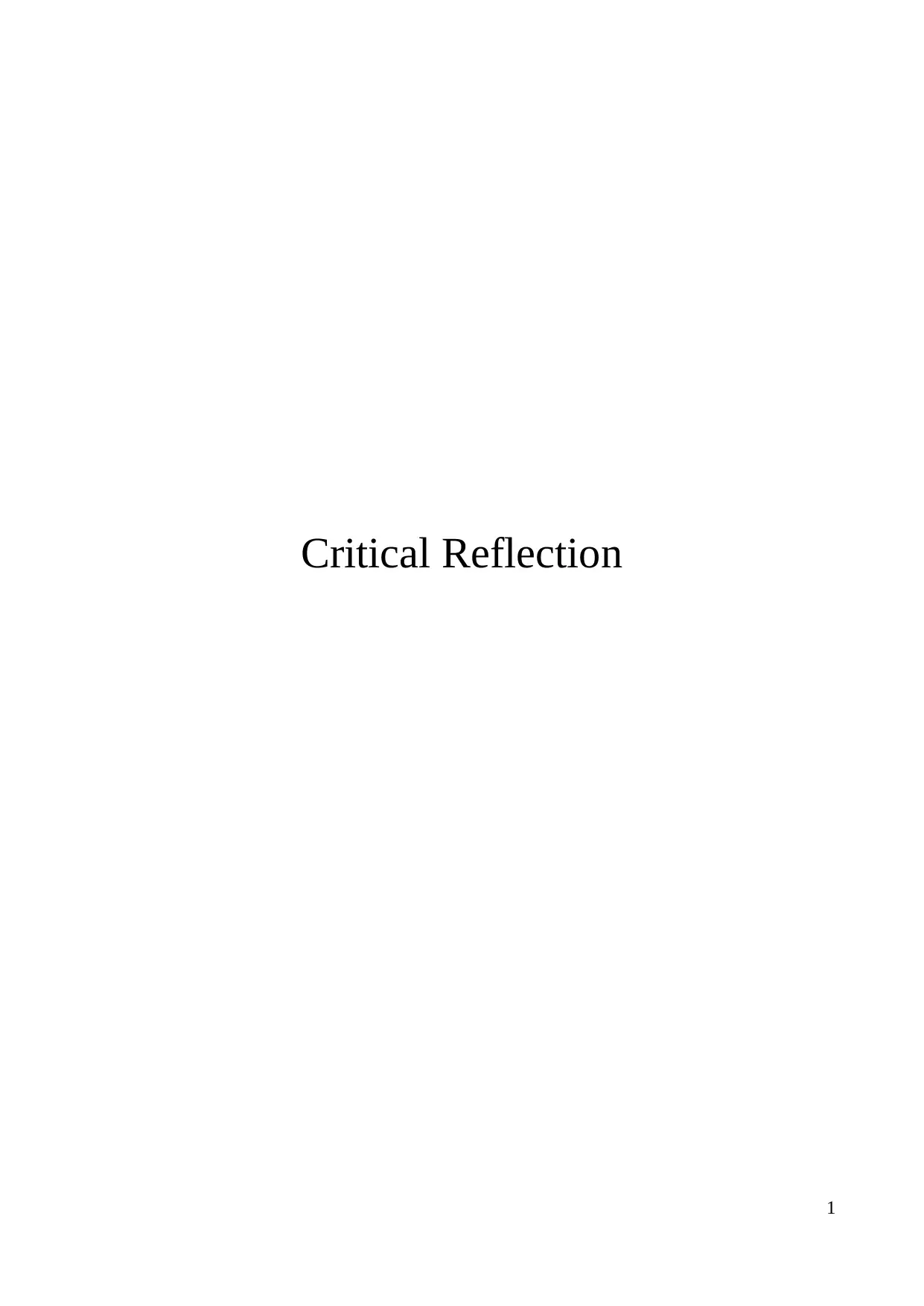
Critical Reflection
1
1
Paraphrase This Document
Need a fresh take? Get an instant paraphrase of this document with our AI Paraphraser
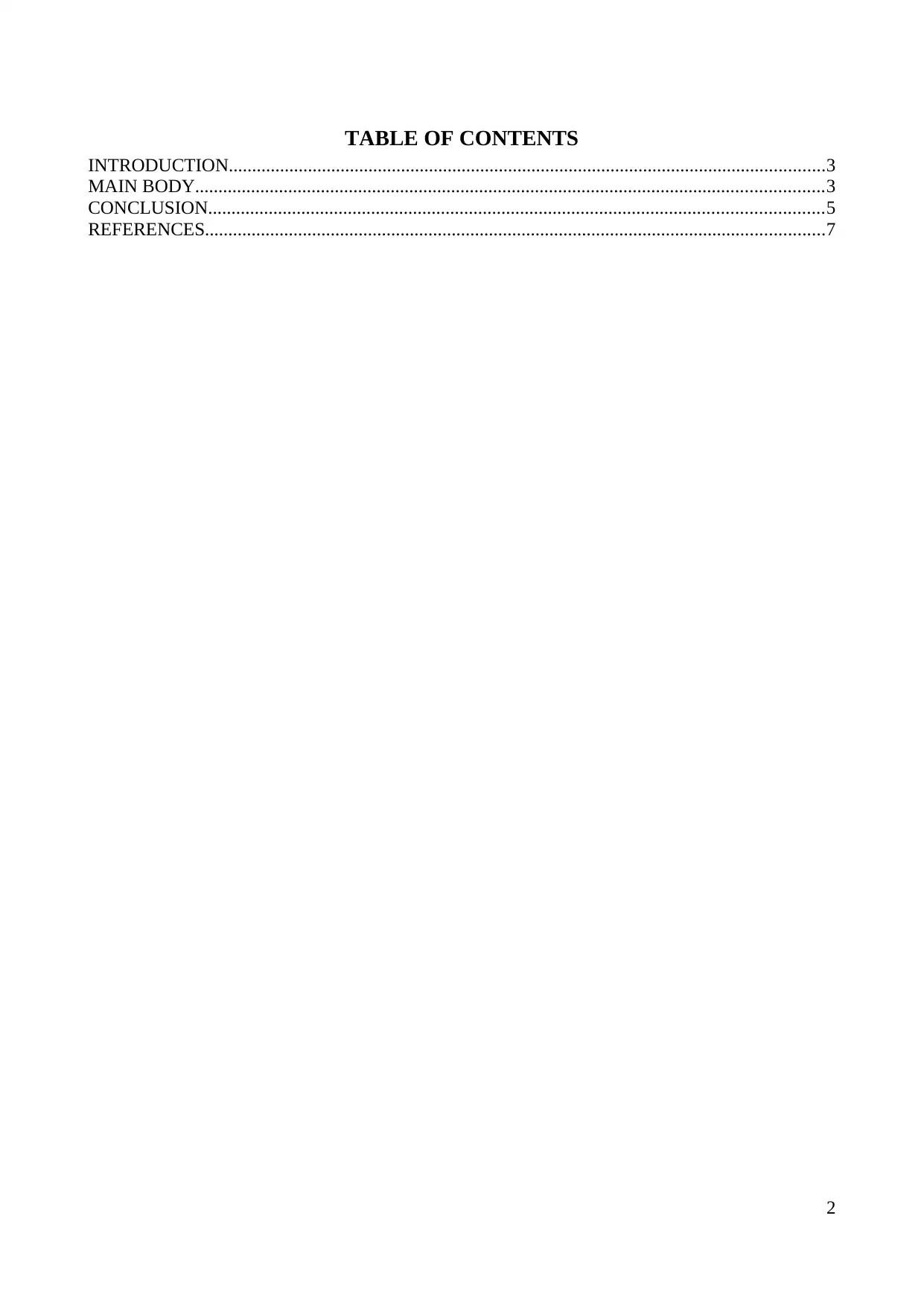
TABLE OF CONTENTS
INTRODUCTION................................................................................................................................3
MAIN BODY.......................................................................................................................................3
CONCLUSION....................................................................................................................................5
REFERENCES.....................................................................................................................................7
2
INTRODUCTION................................................................................................................................3
MAIN BODY.......................................................................................................................................3
CONCLUSION....................................................................................................................................5
REFERENCES.....................................................................................................................................7
2
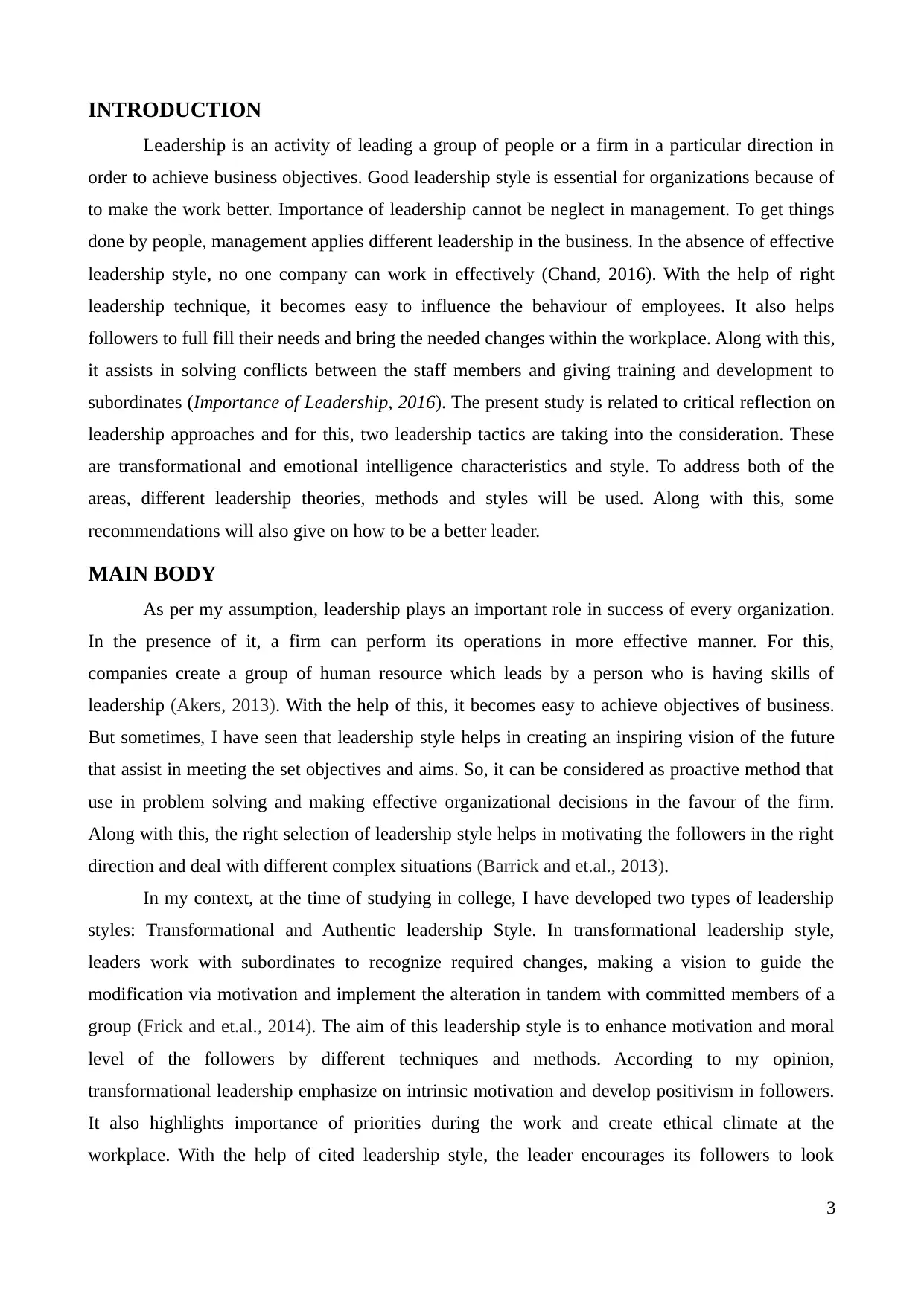
INTRODUCTION
Leadership is an activity of leading a group of people or a firm in a particular direction in
order to achieve business objectives. Good leadership style is essential for organizations because of
to make the work better. Importance of leadership cannot be neglect in management. To get things
done by people, management applies different leadership in the business. In the absence of effective
leadership style, no one company can work in effectively (Chand, 2016). With the help of right
leadership technique, it becomes easy to influence the behaviour of employees. It also helps
followers to full fill their needs and bring the needed changes within the workplace. Along with this,
it assists in solving conflicts between the staff members and giving training and development to
subordinates (Importance of Leadership, 2016). The present study is related to critical reflection on
leadership approaches and for this, two leadership tactics are taking into the consideration. These
are transformational and emotional intelligence characteristics and style. To address both of the
areas, different leadership theories, methods and styles will be used. Along with this, some
recommendations will also give on how to be a better leader.
MAIN BODY
As per my assumption, leadership plays an important role in success of every organization.
In the presence of it, a firm can perform its operations in more effective manner. For this,
companies create a group of human resource which leads by a person who is having skills of
leadership (Akers, 2013). With the help of this, it becomes easy to achieve objectives of business.
But sometimes, I have seen that leadership style helps in creating an inspiring vision of the future
that assist in meeting the set objectives and aims. So, it can be considered as proactive method that
use in problem solving and making effective organizational decisions in the favour of the firm.
Along with this, the right selection of leadership style helps in motivating the followers in the right
direction and deal with different complex situations (Barrick and et.al., 2013).
In my context, at the time of studying in college, I have developed two types of leadership
styles: Transformational and Authentic leadership Style. In transformational leadership style,
leaders work with subordinates to recognize required changes, making a vision to guide the
modification via motivation and implement the alteration in tandem with committed members of a
group (Frick and et.al., 2014). The aim of this leadership style is to enhance motivation and moral
level of the followers by different techniques and methods. According to my opinion,
transformational leadership emphasize on intrinsic motivation and develop positivism in followers.
It also highlights importance of priorities during the work and create ethical climate at the
workplace. With the help of cited leadership style, the leader encourages its followers to look
3
Leadership is an activity of leading a group of people or a firm in a particular direction in
order to achieve business objectives. Good leadership style is essential for organizations because of
to make the work better. Importance of leadership cannot be neglect in management. To get things
done by people, management applies different leadership in the business. In the absence of effective
leadership style, no one company can work in effectively (Chand, 2016). With the help of right
leadership technique, it becomes easy to influence the behaviour of employees. It also helps
followers to full fill their needs and bring the needed changes within the workplace. Along with this,
it assists in solving conflicts between the staff members and giving training and development to
subordinates (Importance of Leadership, 2016). The present study is related to critical reflection on
leadership approaches and for this, two leadership tactics are taking into the consideration. These
are transformational and emotional intelligence characteristics and style. To address both of the
areas, different leadership theories, methods and styles will be used. Along with this, some
recommendations will also give on how to be a better leader.
MAIN BODY
As per my assumption, leadership plays an important role in success of every organization.
In the presence of it, a firm can perform its operations in more effective manner. For this,
companies create a group of human resource which leads by a person who is having skills of
leadership (Akers, 2013). With the help of this, it becomes easy to achieve objectives of business.
But sometimes, I have seen that leadership style helps in creating an inspiring vision of the future
that assist in meeting the set objectives and aims. So, it can be considered as proactive method that
use in problem solving and making effective organizational decisions in the favour of the firm.
Along with this, the right selection of leadership style helps in motivating the followers in the right
direction and deal with different complex situations (Barrick and et.al., 2013).
In my context, at the time of studying in college, I have developed two types of leadership
styles: Transformational and Authentic leadership Style. In transformational leadership style,
leaders work with subordinates to recognize required changes, making a vision to guide the
modification via motivation and implement the alteration in tandem with committed members of a
group (Frick and et.al., 2014). The aim of this leadership style is to enhance motivation and moral
level of the followers by different techniques and methods. According to my opinion,
transformational leadership emphasize on intrinsic motivation and develop positivism in followers.
It also highlights importance of priorities during the work and create ethical climate at the
workplace. With the help of cited leadership style, the leader encourages its followers to look
3
⊘ This is a preview!⊘
Do you want full access?
Subscribe today to unlock all pages.

Trusted by 1+ million students worldwide
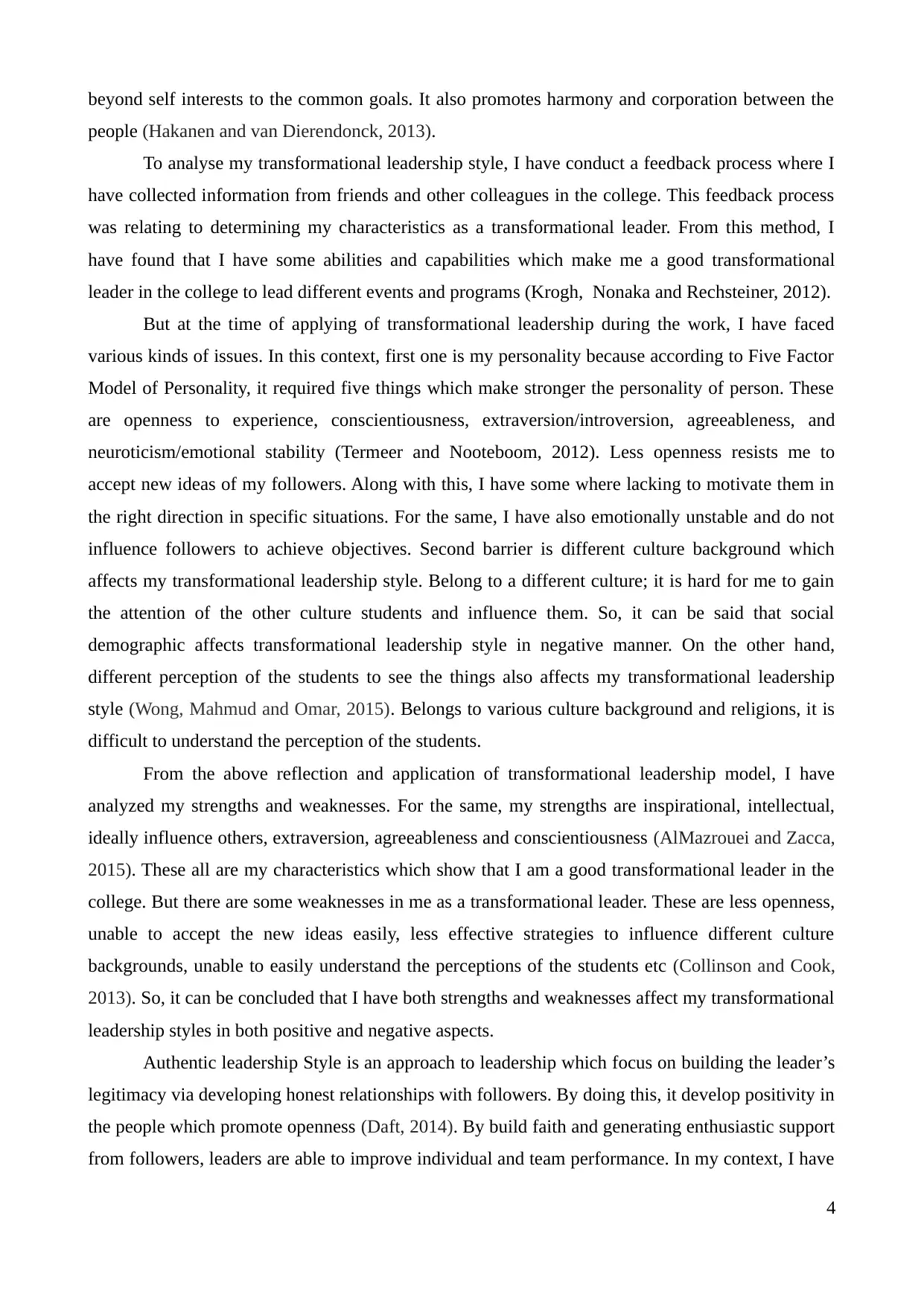
beyond self interests to the common goals. It also promotes harmony and corporation between the
people (Hakanen and van Dierendonck, 2013).
To analyse my transformational leadership style, I have conduct a feedback process where I
have collected information from friends and other colleagues in the college. This feedback process
was relating to determining my characteristics as a transformational leader. From this method, I
have found that I have some abilities and capabilities which make me a good transformational
leader in the college to lead different events and programs (Krogh, Nonaka and Rechsteiner, 2012).
But at the time of applying of transformational leadership during the work, I have faced
various kinds of issues. In this context, first one is my personality because according to Five Factor
Model of Personality, it required five things which make stronger the personality of person. These
are openness to experience, conscientiousness, extraversion/introversion, agreeableness, and
neuroticism/emotional stability (Termeer and Nooteboom, 2012). Less openness resists me to
accept new ideas of my followers. Along with this, I have some where lacking to motivate them in
the right direction in specific situations. For the same, I have also emotionally unstable and do not
influence followers to achieve objectives. Second barrier is different culture background which
affects my transformational leadership style. Belong to a different culture; it is hard for me to gain
the attention of the other culture students and influence them. So, it can be said that social
demographic affects transformational leadership style in negative manner. On the other hand,
different perception of the students to see the things also affects my transformational leadership
style (Wong, Mahmud and Omar, 2015). Belongs to various culture background and religions, it is
difficult to understand the perception of the students.
From the above reflection and application of transformational leadership model, I have
analyzed my strengths and weaknesses. For the same, my strengths are inspirational, intellectual,
ideally influence others, extraversion, agreeableness and conscientiousness (AlMazrouei and Zacca,
2015). These all are my characteristics which show that I am a good transformational leader in the
college. But there are some weaknesses in me as a transformational leader. These are less openness,
unable to accept the new ideas easily, less effective strategies to influence different culture
backgrounds, unable to easily understand the perceptions of the students etc (Collinson and Cook,
2013). So, it can be concluded that I have both strengths and weaknesses affect my transformational
leadership styles in both positive and negative aspects.
Authentic leadership Style is an approach to leadership which focus on building the leader’s
legitimacy via developing honest relationships with followers. By doing this, it develop positivity in
the people which promote openness (Daft, 2014). By build faith and generating enthusiastic support
from followers, leaders are able to improve individual and team performance. In my context, I have
4
people (Hakanen and van Dierendonck, 2013).
To analyse my transformational leadership style, I have conduct a feedback process where I
have collected information from friends and other colleagues in the college. This feedback process
was relating to determining my characteristics as a transformational leader. From this method, I
have found that I have some abilities and capabilities which make me a good transformational
leader in the college to lead different events and programs (Krogh, Nonaka and Rechsteiner, 2012).
But at the time of applying of transformational leadership during the work, I have faced
various kinds of issues. In this context, first one is my personality because according to Five Factor
Model of Personality, it required five things which make stronger the personality of person. These
are openness to experience, conscientiousness, extraversion/introversion, agreeableness, and
neuroticism/emotional stability (Termeer and Nooteboom, 2012). Less openness resists me to
accept new ideas of my followers. Along with this, I have some where lacking to motivate them in
the right direction in specific situations. For the same, I have also emotionally unstable and do not
influence followers to achieve objectives. Second barrier is different culture background which
affects my transformational leadership style. Belong to a different culture; it is hard for me to gain
the attention of the other culture students and influence them. So, it can be said that social
demographic affects transformational leadership style in negative manner. On the other hand,
different perception of the students to see the things also affects my transformational leadership
style (Wong, Mahmud and Omar, 2015). Belongs to various culture background and religions, it is
difficult to understand the perception of the students.
From the above reflection and application of transformational leadership model, I have
analyzed my strengths and weaknesses. For the same, my strengths are inspirational, intellectual,
ideally influence others, extraversion, agreeableness and conscientiousness (AlMazrouei and Zacca,
2015). These all are my characteristics which show that I am a good transformational leader in the
college. But there are some weaknesses in me as a transformational leader. These are less openness,
unable to accept the new ideas easily, less effective strategies to influence different culture
backgrounds, unable to easily understand the perceptions of the students etc (Collinson and Cook,
2013). So, it can be concluded that I have both strengths and weaknesses affect my transformational
leadership styles in both positive and negative aspects.
Authentic leadership Style is an approach to leadership which focus on building the leader’s
legitimacy via developing honest relationships with followers. By doing this, it develop positivity in
the people which promote openness (Daft, 2014). By build faith and generating enthusiastic support
from followers, leaders are able to improve individual and team performance. In my context, I have
4
Paraphrase This Document
Need a fresh take? Get an instant paraphrase of this document with our AI Paraphraser
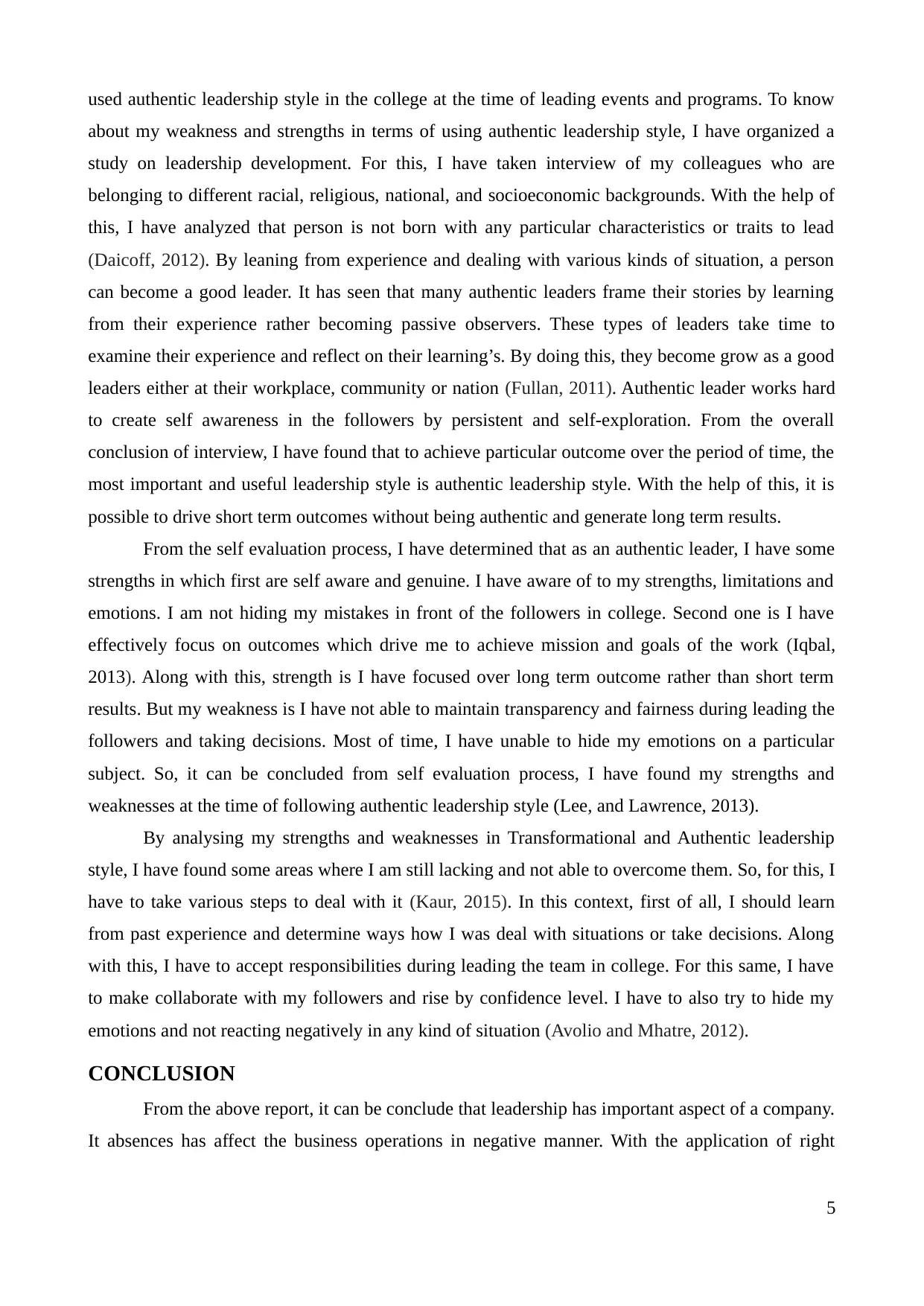
used authentic leadership style in the college at the time of leading events and programs. To know
about my weakness and strengths in terms of using authentic leadership style, I have organized a
study on leadership development. For this, I have taken interview of my colleagues who are
belonging to different racial, religious, national, and socioeconomic backgrounds. With the help of
this, I have analyzed that person is not born with any particular characteristics or traits to lead
(Daicoff, 2012). By leaning from experience and dealing with various kinds of situation, a person
can become a good leader. It has seen that many authentic leaders frame their stories by learning
from their experience rather becoming passive observers. These types of leaders take time to
examine their experience and reflect on their learning’s. By doing this, they become grow as a good
leaders either at their workplace, community or nation (Fullan, 2011). Authentic leader works hard
to create self awareness in the followers by persistent and self-exploration. From the overall
conclusion of interview, I have found that to achieve particular outcome over the period of time, the
most important and useful leadership style is authentic leadership style. With the help of this, it is
possible to drive short term outcomes without being authentic and generate long term results.
From the self evaluation process, I have determined that as an authentic leader, I have some
strengths in which first are self aware and genuine. I have aware of to my strengths, limitations and
emotions. I am not hiding my mistakes in front of the followers in college. Second one is I have
effectively focus on outcomes which drive me to achieve mission and goals of the work (Iqbal,
2013). Along with this, strength is I have focused over long term outcome rather than short term
results. But my weakness is I have not able to maintain transparency and fairness during leading the
followers and taking decisions. Most of time, I have unable to hide my emotions on a particular
subject. So, it can be concluded from self evaluation process, I have found my strengths and
weaknesses at the time of following authentic leadership style (Lee, and Lawrence, 2013).
By analysing my strengths and weaknesses in Transformational and Authentic leadership
style, I have found some areas where I am still lacking and not able to overcome them. So, for this, I
have to take various steps to deal with it (Kaur, 2015). In this context, first of all, I should learn
from past experience and determine ways how I was deal with situations or take decisions. Along
with this, I have to accept responsibilities during leading the team in college. For this same, I have
to make collaborate with my followers and rise by confidence level. I have to also try to hide my
emotions and not reacting negatively in any kind of situation (Avolio and Mhatre, 2012).
CONCLUSION
From the above report, it can be conclude that leadership has important aspect of a company.
It absences has affect the business operations in negative manner. With the application of right
5
about my weakness and strengths in terms of using authentic leadership style, I have organized a
study on leadership development. For this, I have taken interview of my colleagues who are
belonging to different racial, religious, national, and socioeconomic backgrounds. With the help of
this, I have analyzed that person is not born with any particular characteristics or traits to lead
(Daicoff, 2012). By leaning from experience and dealing with various kinds of situation, a person
can become a good leader. It has seen that many authentic leaders frame their stories by learning
from their experience rather becoming passive observers. These types of leaders take time to
examine their experience and reflect on their learning’s. By doing this, they become grow as a good
leaders either at their workplace, community or nation (Fullan, 2011). Authentic leader works hard
to create self awareness in the followers by persistent and self-exploration. From the overall
conclusion of interview, I have found that to achieve particular outcome over the period of time, the
most important and useful leadership style is authentic leadership style. With the help of this, it is
possible to drive short term outcomes without being authentic and generate long term results.
From the self evaluation process, I have determined that as an authentic leader, I have some
strengths in which first are self aware and genuine. I have aware of to my strengths, limitations and
emotions. I am not hiding my mistakes in front of the followers in college. Second one is I have
effectively focus on outcomes which drive me to achieve mission and goals of the work (Iqbal,
2013). Along with this, strength is I have focused over long term outcome rather than short term
results. But my weakness is I have not able to maintain transparency and fairness during leading the
followers and taking decisions. Most of time, I have unable to hide my emotions on a particular
subject. So, it can be concluded from self evaluation process, I have found my strengths and
weaknesses at the time of following authentic leadership style (Lee, and Lawrence, 2013).
By analysing my strengths and weaknesses in Transformational and Authentic leadership
style, I have found some areas where I am still lacking and not able to overcome them. So, for this, I
have to take various steps to deal with it (Kaur, 2015). In this context, first of all, I should learn
from past experience and determine ways how I was deal with situations or take decisions. Along
with this, I have to accept responsibilities during leading the team in college. For this same, I have
to make collaborate with my followers and rise by confidence level. I have to also try to hide my
emotions and not reacting negatively in any kind of situation (Avolio and Mhatre, 2012).
CONCLUSION
From the above report, it can be conclude that leadership has important aspect of a company.
It absences has affect the business operations in negative manner. With the application of right
5
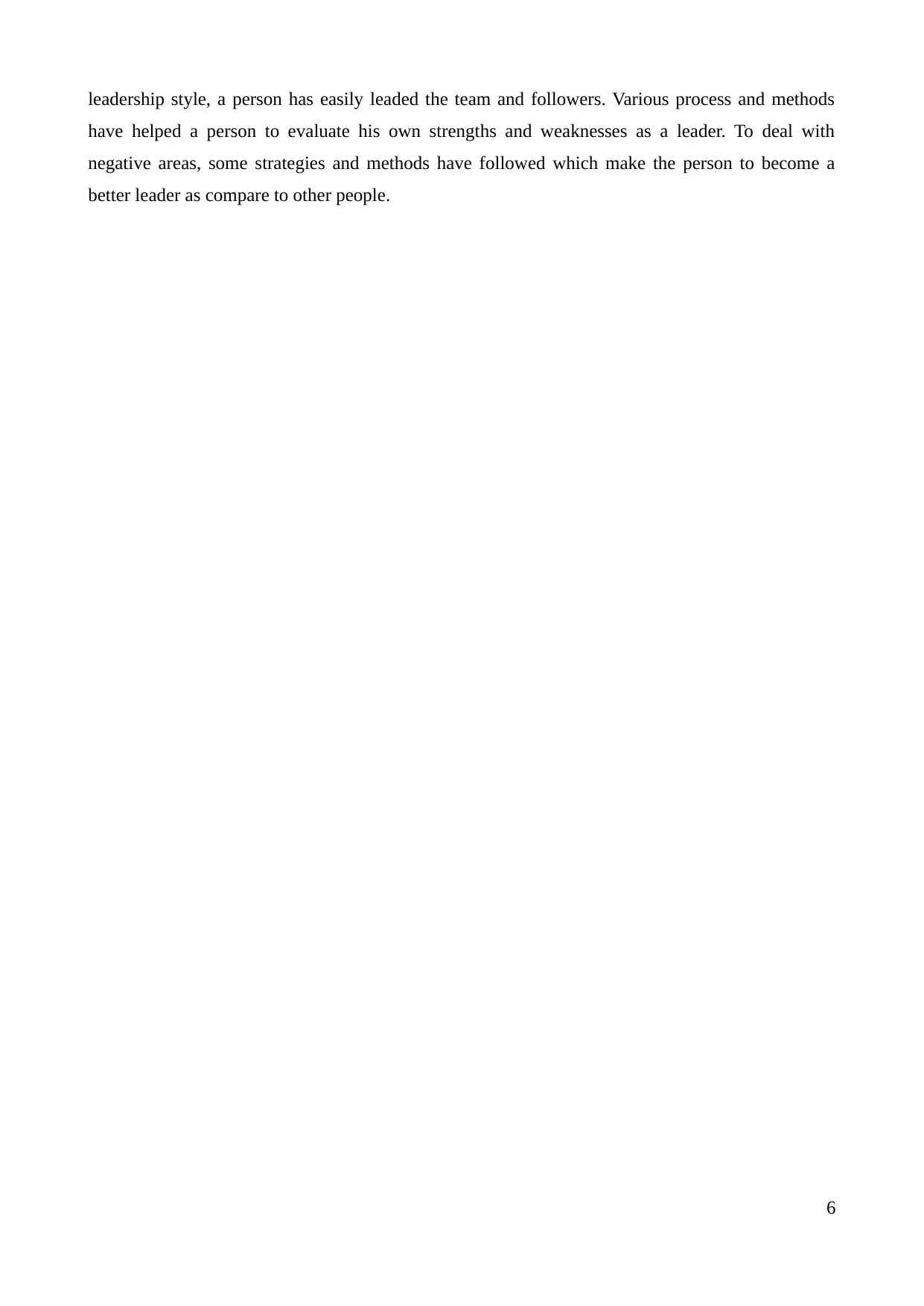
leadership style, a person has easily leaded the team and followers. Various process and methods
have helped a person to evaluate his own strengths and weaknesses as a leader. To deal with
negative areas, some strategies and methods have followed which make the person to become a
better leader as compare to other people.
6
have helped a person to evaluate his own strengths and weaknesses as a leader. To deal with
negative areas, some strategies and methods have followed which make the person to become a
better leader as compare to other people.
6
⊘ This is a preview!⊘
Do you want full access?
Subscribe today to unlock all pages.

Trusted by 1+ million students worldwide
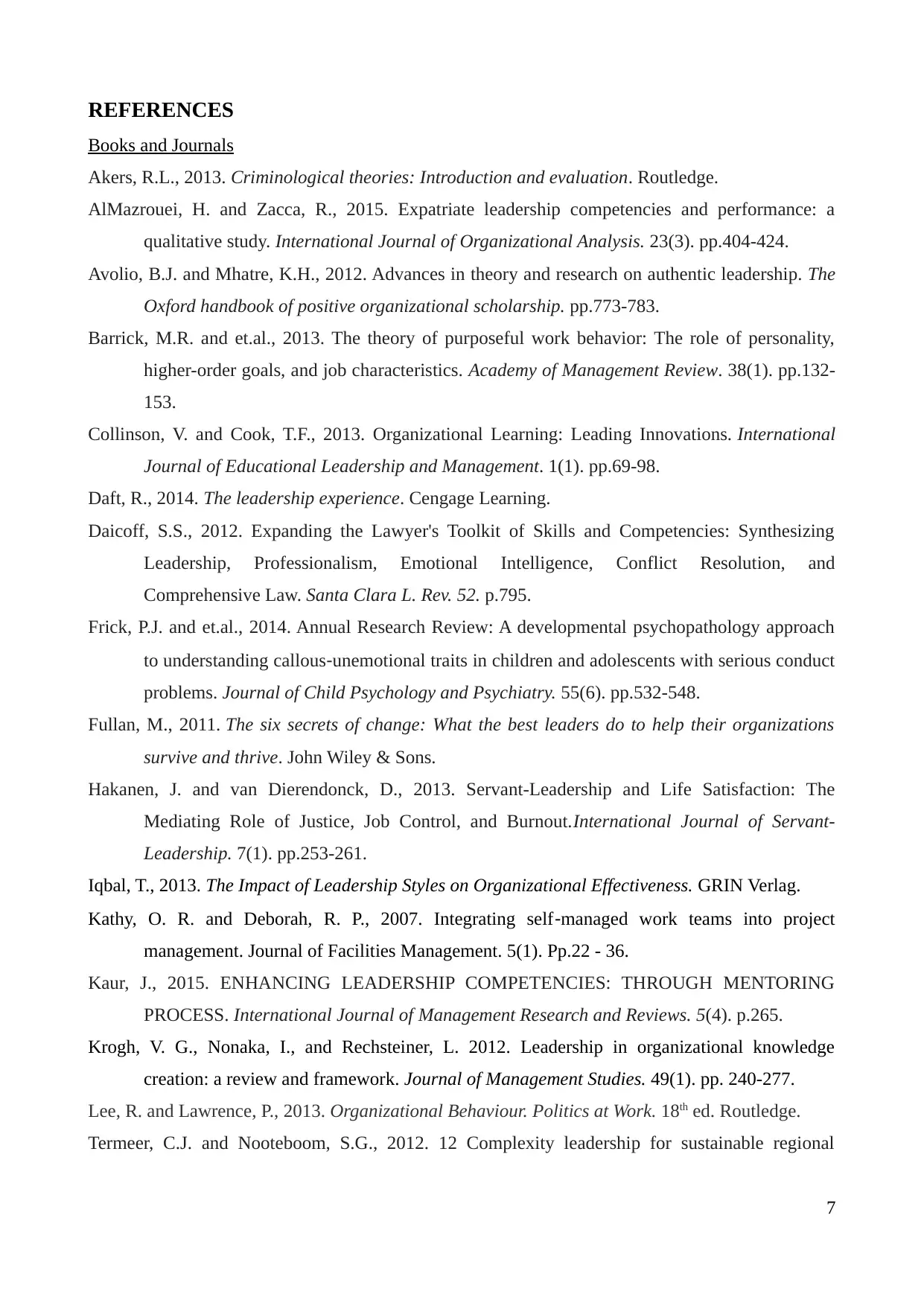
REFERENCES
Books and Journals
Akers, R.L., 2013. Criminological theories: Introduction and evaluation. Routledge.
AlMazrouei, H. and Zacca, R., 2015. Expatriate leadership competencies and performance: a
qualitative study. International Journal of Organizational Analysis. 23(3). pp.404-424.
Avolio, B.J. and Mhatre, K.H., 2012. Advances in theory and research on authentic leadership. The
Oxford handbook of positive organizational scholarship. pp.773-783.
Barrick, M.R. and et.al., 2013. The theory of purposeful work behavior: The role of personality,
higher-order goals, and job characteristics. Academy of Management Review. 38(1). pp.132-
153.
Collinson, V. and Cook, T.F., 2013. Organizational Learning: Leading Innovations. International
Journal of Educational Leadership and Management. 1(1). pp.69-98.
Daft, R., 2014. The leadership experience. Cengage Learning.
Daicoff, S.S., 2012. Expanding the Lawyer's Toolkit of Skills and Competencies: Synthesizing
Leadership, Professionalism, Emotional Intelligence, Conflict Resolution, and
Comprehensive Law. Santa Clara L. Rev. 52. p.795.
Frick, P.J. and et.al., 2014. Annual Research Review: A developmental psychopathology approach
to understanding callous‐unemotional traits in children and adolescents with serious conduct
problems. Journal of Child Psychology and Psychiatry. 55(6). pp.532-548.
Fullan, M., 2011. The six secrets of change: What the best leaders do to help their organizations
survive and thrive. John Wiley & Sons.
Hakanen, J. and van Dierendonck, D., 2013. Servant-Leadership and Life Satisfaction: The
Mediating Role of Justice, Job Control, and Burnout.International Journal of Servant-
Leadership. 7(1). pp.253-261.
Iqbal, T., 2013. The Impact of Leadership Styles on Organizational Effectiveness. GRIN Verlag.
Kathy, O. R. and Deborah, R. P., 2007. Integrating self‐managed work teams into project
management. Journal of Facilities Management. 5(1). Pp.22 - 36.
Kaur, J., 2015. ENHANCING LEADERSHIP COMPETENCIES: THROUGH MENTORING
PROCESS. International Journal of Management Research and Reviews. 5(4). p.265.
Krogh, V. G., Nonaka, I., and Rechsteiner, L. 2012. Leadership in organizational knowledge
creation: a review and framework. Journal of Management Studies. 49(1). pp. 240-277.
Lee, R. and Lawrence, P., 2013. Organizational Behaviour. Politics at Work. 18th ed. Routledge.
Termeer, C.J. and Nooteboom, S.G., 2012. 12 Complexity leadership for sustainable regional
7
Books and Journals
Akers, R.L., 2013. Criminological theories: Introduction and evaluation. Routledge.
AlMazrouei, H. and Zacca, R., 2015. Expatriate leadership competencies and performance: a
qualitative study. International Journal of Organizational Analysis. 23(3). pp.404-424.
Avolio, B.J. and Mhatre, K.H., 2012. Advances in theory and research on authentic leadership. The
Oxford handbook of positive organizational scholarship. pp.773-783.
Barrick, M.R. and et.al., 2013. The theory of purposeful work behavior: The role of personality,
higher-order goals, and job characteristics. Academy of Management Review. 38(1). pp.132-
153.
Collinson, V. and Cook, T.F., 2013. Organizational Learning: Leading Innovations. International
Journal of Educational Leadership and Management. 1(1). pp.69-98.
Daft, R., 2014. The leadership experience. Cengage Learning.
Daicoff, S.S., 2012. Expanding the Lawyer's Toolkit of Skills and Competencies: Synthesizing
Leadership, Professionalism, Emotional Intelligence, Conflict Resolution, and
Comprehensive Law. Santa Clara L. Rev. 52. p.795.
Frick, P.J. and et.al., 2014. Annual Research Review: A developmental psychopathology approach
to understanding callous‐unemotional traits in children and adolescents with serious conduct
problems. Journal of Child Psychology and Psychiatry. 55(6). pp.532-548.
Fullan, M., 2011. The six secrets of change: What the best leaders do to help their organizations
survive and thrive. John Wiley & Sons.
Hakanen, J. and van Dierendonck, D., 2013. Servant-Leadership and Life Satisfaction: The
Mediating Role of Justice, Job Control, and Burnout.International Journal of Servant-
Leadership. 7(1). pp.253-261.
Iqbal, T., 2013. The Impact of Leadership Styles on Organizational Effectiveness. GRIN Verlag.
Kathy, O. R. and Deborah, R. P., 2007. Integrating self‐managed work teams into project
management. Journal of Facilities Management. 5(1). Pp.22 - 36.
Kaur, J., 2015. ENHANCING LEADERSHIP COMPETENCIES: THROUGH MENTORING
PROCESS. International Journal of Management Research and Reviews. 5(4). p.265.
Krogh, V. G., Nonaka, I., and Rechsteiner, L. 2012. Leadership in organizational knowledge
creation: a review and framework. Journal of Management Studies. 49(1). pp. 240-277.
Lee, R. and Lawrence, P., 2013. Organizational Behaviour. Politics at Work. 18th ed. Routledge.
Termeer, C.J. and Nooteboom, S.G., 2012. 12 Complexity leadership for sustainable regional
7
Paraphrase This Document
Need a fresh take? Get an instant paraphrase of this document with our AI Paraphraser
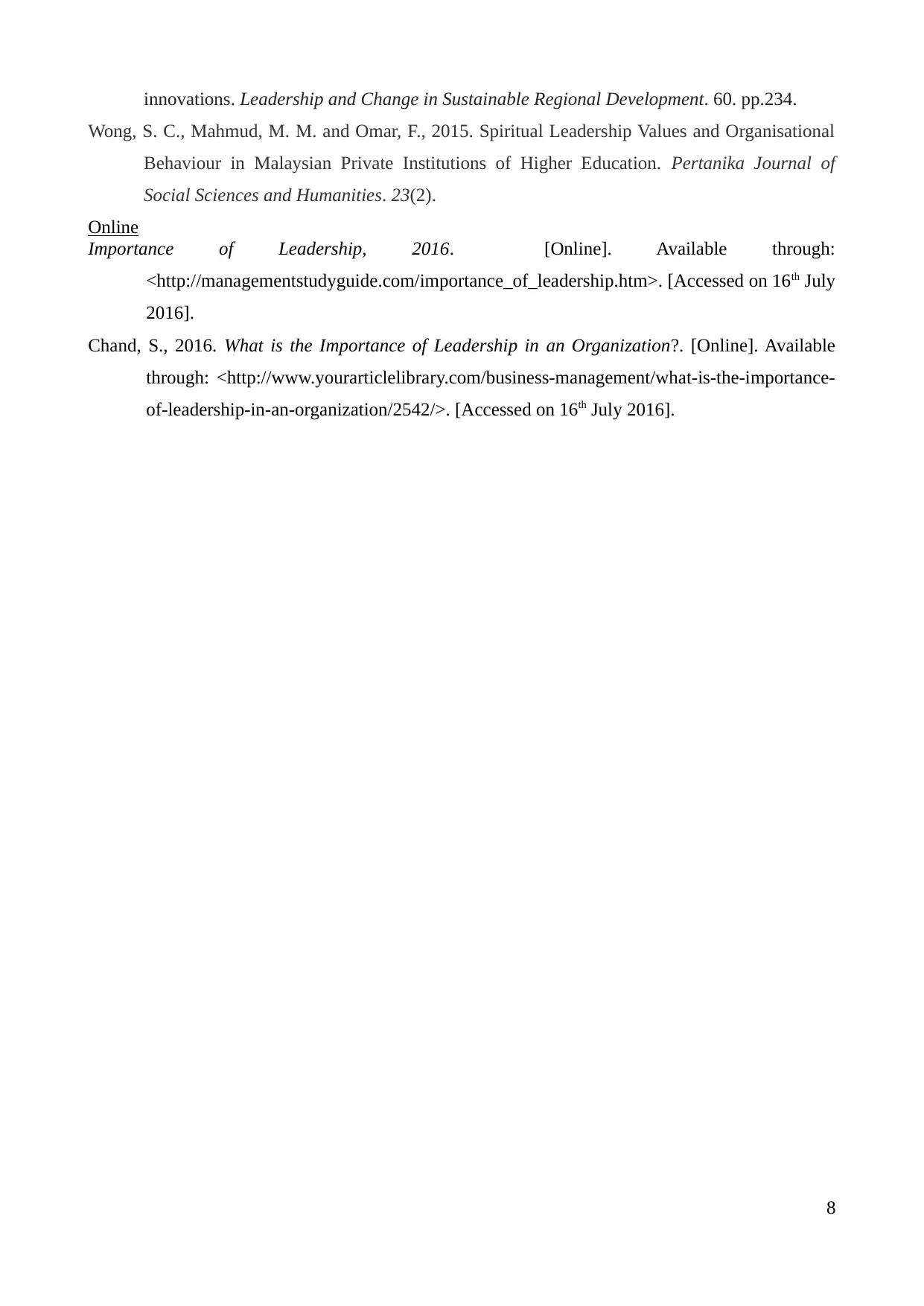
innovations. Leadership and Change in Sustainable Regional Development. 60. pp.234.
Wong, S. C., Mahmud, M. M. and Omar, F., 2015. Spiritual Leadership Values and Organisational
Behaviour in Malaysian Private Institutions of Higher Education. Pertanika Journal of
Social Sciences and Humanities. 23(2).
Online
Importance of Leadership, 2016. [Online]. Available through:
<http://managementstudyguide.com/importance_of_leadership.htm>. [Accessed on 16th July
2016].
Chand, S., 2016. What is the Importance of Leadership in an Organization?. [Online]. Available
through: <http://www.yourarticlelibrary.com/business-management/what-is-the-importance-
of-leadership-in-an-organization/2542/>. [Accessed on 16th July 2016].
8
Wong, S. C., Mahmud, M. M. and Omar, F., 2015. Spiritual Leadership Values and Organisational
Behaviour in Malaysian Private Institutions of Higher Education. Pertanika Journal of
Social Sciences and Humanities. 23(2).
Online
Importance of Leadership, 2016. [Online]. Available through:
<http://managementstudyguide.com/importance_of_leadership.htm>. [Accessed on 16th July
2016].
Chand, S., 2016. What is the Importance of Leadership in an Organization?. [Online]. Available
through: <http://www.yourarticlelibrary.com/business-management/what-is-the-importance-
of-leadership-in-an-organization/2542/>. [Accessed on 16th July 2016].
8
1 out of 8
Related Documents
Your All-in-One AI-Powered Toolkit for Academic Success.
+13062052269
info@desklib.com
Available 24*7 on WhatsApp / Email
![[object Object]](/_next/static/media/star-bottom.7253800d.svg)
Unlock your academic potential
Copyright © 2020–2025 A2Z Services. All Rights Reserved. Developed and managed by ZUCOL.




